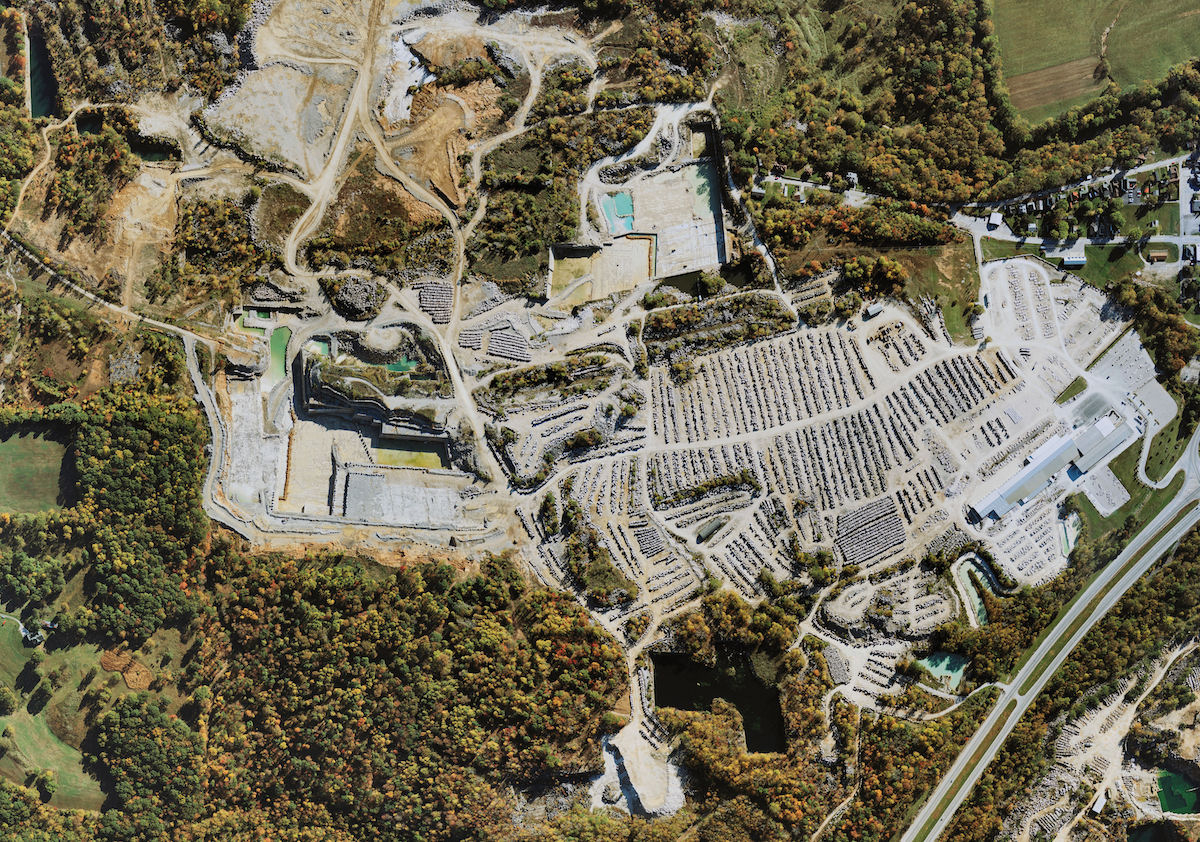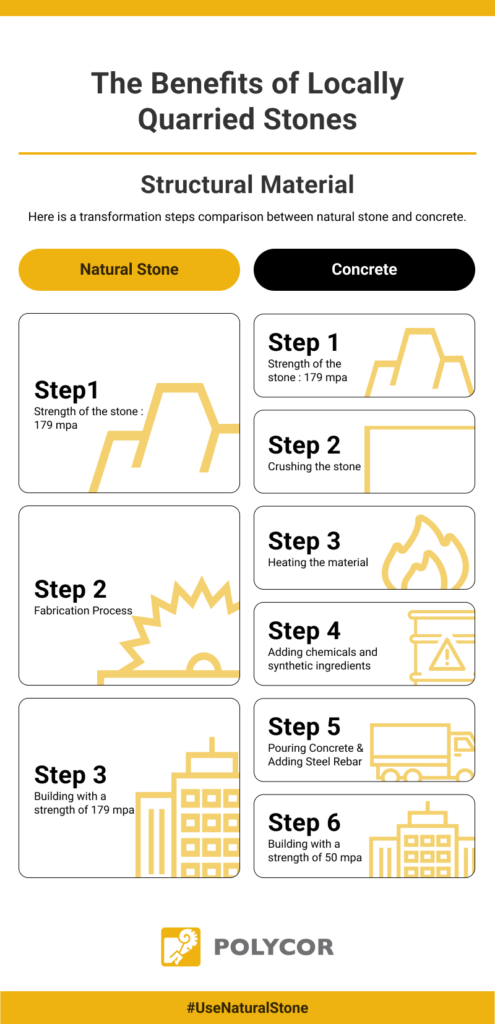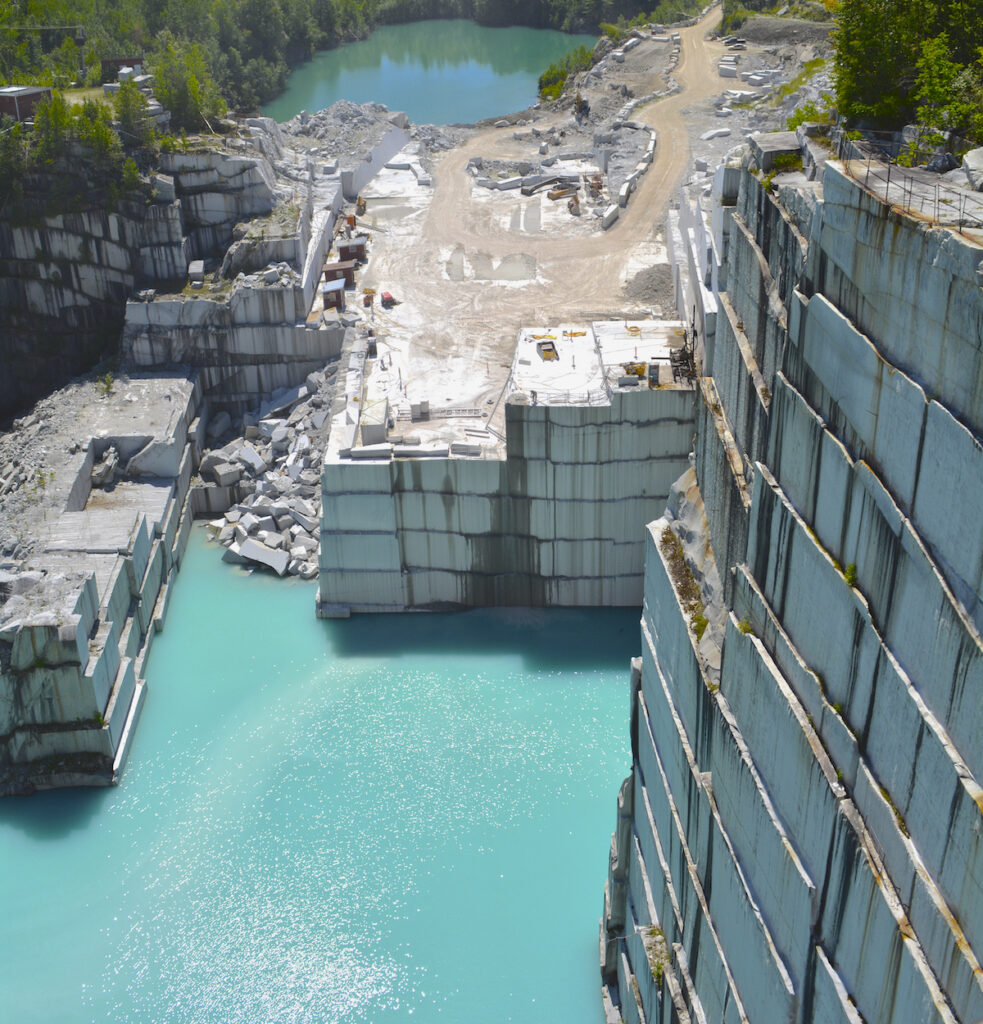
Naturally Sustainable
The Sustainability
of Stone as a Material
Stone is one of the most sustainable materials
There are many sustainable practices that manufacturers of building materials can adopt, but there is only one building material that is inherently durable and healthy: natural stone.
Natural stone is durable, low carbon, VOC free, reusable and recyclable with great energy and maintenance performance. Using natural stone can help projects earn credits under many different green building standards such as LEED®, Living Building Challenge, BREEAM and others.
Provides a Lifetime of Reliable, Environmentally-Friendly Use
Reduces Embodied Carbon Of Projects
Minimizes Health Risks From VOC Emissions
Offers a Natural, Reusable and Recyclable Material
Reduces Energy Loss and Maintenance Requirements
Key Facts & Figures
0%
VOCs Emission
Natural Stone is an inherently non-emitting source of VOCs.
100%
Reusable or Recyclable
The most ancient of all building materials stone can be reused and recycled multiple times during its life cycle
+100
Years of Durability
Natural stone is the most durable building material of Earth.

The Benefits of
Locally Quarried
Stones
Beyond the fact that when you use Polycor, you are getting such a high quality stone, by buying one of our locally sourced natural stones, you’re minimizing shipping and transportation, which saves fossil fuels and money in taxes and transportation costs, while boosting the local economy and community.

The Impact of Choosing Natural Stones as a Building Material on Sustainability and the Environment
Overview of Natural Stone
Natural stone building materials have been used in construction for centuries, thanks to their durability and aesthetic appeal. While each type of stone has its own individual characteristics, they are all renowned for their weather resistance capabilities as well as their longevity.
Architects take advantage of natural stones such as granite, marble and limestone to create beautiful designs that stay intact over time. This variability and increased stability make it the perfect tool to create majestic buildings with a timeless look that will withstand the test of time.

Using Natural Stone for a Sustainable Built Environment
As sustainability becomes more of a priority in architecture, using natural stone as a building material is an excellent way to reduce embodied carbon associated with structures. This sturdy and reliable material has significant environmental benefits when compared to other building materials.
Natural stone requires less energy for production and provides greater levels of thermal mass, meaning the interior climate of buildings can be better regulated, decreasing operating costs and maintaining structural integrity for longer periods of time. Architects should consider natural stone for their sustainable projects – its timeless beauty combined with its sustainable attributes makes it the ideal choice.
By choosing locally quarried, domestic natural stone for your projects, you can have an immensely positive impact on local economies as well. This, in turn, becomes a viable solution for achieving a beautiful, unique and sustainable outcome, while also supporting local businesses and employment rates across the country.
Long-term stone quarrying operations, such as those found at Polycor’s Indiana Limestone sites in Bedford and Bloomington, Indiana, as well as Graniteville and Barre, Vermont have served as major drivers to local commerce for well over 100 years.
Choosing nearby sourced materials not only creates jobs and supports community development, but it reduces transportation emissions by limiting materials imports, many of which are oceans and continents away. You can use these locally quarried and fabricated natural stones to create stunning architecture and add sustainable value to your projects.
Benefits of using natural stone
Provides a Lifetime of Reliable, Environmentally-Friendly Use
Contribution to Aesthetic Beauty of the Built Environment
The addition of natural stone to any architectural project is a timeless way to enhance the aesthetics of the built environment. Natural stone has been utilized in architecture for centuries, and its adaptive nature provides a range of design opportunities. Whether used as an external feature or interior element, natural stone can subtly shift light and create powerful visual statements within any space.
-
READ MORE
Architects are turning to natural stones as an environmentally friendly alternative to synthetic materials thanks to their integrated properties, longevity, and unique strength. From limestone walls that divide spaces with rustic charm or granite columns that define grand formal entrances, natural stone can easily punctuate elegance in any structure. Investing in quality-grade stone products ensures that your designs will last for generations – providing lasting aesthetic beauty throughout the lifecycle of your projects.
Architects can help reduce their building’s footprint and enhance sustainability initiatives by using these materials instead of man-made ones in their projects. Ultimately, natural stones help ensure that each building lives up to its intended purpose without damaging our beloved ecosystems.
Benefits of using natural stone
Reduces Embodied Carbon Of Projects
Reducing Carbon Footprint of Buildings with Natural Stones
Architects can play a vital role in reducing embodied carbon from buildings by utilizing natural stones sourced from sustainable environments and specifically stones originating from NSI-373 certified quarry sites. Natural stones, when used in place of concrete and steel, provide a beautiful aesthetic to any building and are significantly better for the environment.
-
READ MORE
Many natural stone suppliers, including Polycor, provide environmental product declarations (EPDs) which make it easier to measure embodied carbon by providing detailed information about an array of materials’ lifecycles, allowing architects and designers to make more educated, informed decisions when selecting materials for a project.
With EPDs, green building codes can be more easily achieved while still meeting the necessary function and beauty that architects strive to create with each build. Natural stones are definitely worth considering as they provide much potential in the reduction of embodied carbon and embodied energy in buildings and can help achieve the targets of construction projects where cities and organizations have pledged to significantly reduce the embodied carbon of their projects.
Benefits of using natural stone
Minimizes Health Risks From VOC Emissions
Increased Biodiversity Due to Non-toxic Materials Used in Building Construction
Architects and designers have the unique ability to play a major role in conserving biodiversity by utilizing non-toxic materials, such as natural stone. Adopting and specifying non-toxic substances for hardscaping and cladding applications especially can have a profound impact on biodiversity in the region.
-
READ MORE
Supporting a variety of wildlife by incorporating eco-friendly materials leads to increases in the local population of insects, amphibians and small animals which all play an important role in the local environment and contribute to a more diverse and abundant ecosystem.
Natural stone is simply a dug-up material that is a single-ingredient product made by the earth and for the earth. Unlike large-scale mining operations of other industries, dimension stone quarrying extraction doesn’t require the use of any chemicals in the process and produces greater yields of usable product. When it’s time to rehabilitate a quarry, there is no contamination to manage or remediate, and nature easily takes over. Stone itself does not emit any VOC’s, does not contain any other foreign ingredients, and is chemically inert, making it incredibly safe for both humans and the environment. In this respect, natural stone is also a smart choice for creating healthy indoor environments as it is one of the best materials for buildings that are healthy for plants and people.
And the quarries themselves, where the stone originates from, can provide magnificent and unique locations for biodiversity during and especially after extraction when new habitats can be sculpted during the reclamation phase, as an increasing number of scientific studies have shown.
Active quarries offer species opportunities through temporary habitats. These include for example, ponds for amphibians, or pioneer habitats which support species that depend on a mixture of bare ground and vegetation landscape.
Quarries contribute to large-scale restoration of biodiversity by creating areas that have been lost in the wider landscape. For example, at Polycor’s former Alberene Soapstone™ quarry site that has since ceased operations, an extensive 40-acre public garden and nature preserve, aptly named Quarry Gardens, was built among the natural ponds and around the soapstone outcrops. The gardens feature two miles of walking trails through native plant communities nurtured by the magnesium-rich soils of the soapstone deposits.
Another example is in Barre, Vermont, where many historic granite quarry pits have now become natural lakes from years of rainwater accumulation teeming with fish, as well as themselves surrounded by thriving forests that are welcomed by the local community.
Benefits of using natural stone
Offers a Natural, Reusable and Recyclable Material
Reduced Waste from Reusing Existing Materials
The quality of repurposed natural stone material is just as reliable as buying new products. Architects understand the power of reducing waste through reuse. Utilizing existing stone building materials is a great way to reduce your carbon footprint, while also saving on costs. Sometimes there’s no need to keep looking for new building materials – reducing waste can be achieved just by upcycling the existing stone building materials themselves.
-
READ MORE
This not only eliminates the need for additional resources needed to extract and fabricate new materials but is also an environmentally conscious decision.
By selecting existing stone materials for adaptive reuse or revitalization projects, architects are directly contributing to the conservation of natural resources and preserving the environment we live in. Reusing traditional stonework is also an effective way to adhere to more sustainable construction practices while at the same time paying homage to the architectural styles of the past. A combination of classical and modern design techniques can add layers of depth and character to any structure. In this way, the choice of building materials has a significant impact on the overall performance results and deserves careful consideration.
Benefits of using natural stone
Reduces Energy Loss and Maintenance Requirements
Cost-Efficiency of Natural Stones in Construction Projects
Natural stones are an incredibly cost-effective solution for large construction and architectural projects. Benefiting from their natural strength, they require less processing to ready them for building projects reducing the overall labor costs associated with them.
-
READ MORE
Additionally, natural stones are highly durable and require very little maintenance over time meaning that there is a significant amount of cost savings in terms of upkeep and repairs as compared to other building materials.
In this way, it provides a lasting value that is hard to come by with other materials. Though their upfront costs are comparable to some other options, they provide greater savings over the long term as well as a stunning visual appeal to your project. Architects can incorporate natural stones into their designs if they want cost-effective results that endure.
Low Maintenance Requirements and High Durability
Natural stone materials can offer architects and construction professionals a lucrative option for projects. They possess high levels of durability, making them an ideal choice for long-term structures thanks to their low maintenance requirements.
-
READ MORE
As these projects require years of service in extreme weather conditions, natural stone offers an assurance of resistance. It is also highly versatile, allowing architects to create a wide range of design styles in both interior or exterior environments.
Additionally, natural stone requires minimal secondary treatment components during the installation process, such as polishes or dyes, to maintain aesthetics, which significantly reduces the amount of time spent on these projects. With its proven reliability and ease of installation, taking advantage of the benefits that natural stone materials have to offer can help architects and construction professionals quickly complete their vision while saving time and costs. Design professionals can select from a wide array of contemporary and classical aesthetics, customized palettes and styles that are bound to fit into any project design concept with ease.

Sustainability Resources
They are quarried from our world-renowned natural stone area, then sawed
and trimmed in our own plants.


